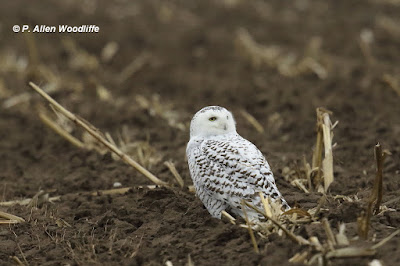Every year is different, of course. This year has been one of the mildest so far, with nary a bit of ice to contend with, for humans or wildlife. That may change somewhat by tomorrow, as it has been slightly below freezing for the last few hours, and will remain below for the next 24-36 hours, if one can believe the weather forecasters. So if that happens, some ice will appear and that isn't necessarily a bad thing. Up until now, the birds have been widely spread, not being constrained by ice in the least, so a bit of ice might get them a bit more concentrated. I hope.
Fortunately this year seems to be great for Snowy Owls....that is three years in a row, which is abnormal. They normally go in cycles and may be in good numbers for a year, maybe two successive ones, and then revert to being a no-show for several years. The area of our Christmas Bird Count has been one of the more reliable areas to find this owl in the winter in southwestern Ontario, but even at that, we've come up empty for as many as 6 years in a row. This is due to the food availability at the time of their breeding, and is affected by lemming cycles. When there are lots of lemmings, there are lots of young owls produced, and when the lemming population takes a nose dive later in the year, it forces the owls to head south for the winter. I'm not sure what three good years in a row means. Three good years of lemming populations? And what is the cause of that? Is it the dreaded climate change, which results in more lemmings in successive years?
At any rate, it is always nice to see Snowy Owls. Yesterday in my travels around the north part of the former Dover Twp, I counted 12 Snowy Owls, one of the highest totals I've ever had at one time. There may have been more that saw me, as several were well out in the field and not easy to spot. Most were on the ground.
Some were on a pole or low structure.
This next image is one I've always been on the lookout for....a raptor of some type on a solar panel, and a bonus is that it is a Snowy! Is it recharging :-)?
There has been a rather large mixed flock of blackbirds north of Mitchell's Bay and south of the Bear Creek Unit of SCNWA. In with the ~5000 birds are up to three male Yellow-headed Blackbirds!
Unfortunately I haven't been able to catch up with this flock yet, so have been forced to use a photo from the spring here.
And truth be told, this large flock has been slightly outside our count circle so they need to come a bit farther south before we can count them for the count week or count day. Here's hoping.....
I did come across a large flock of at least 800 mostly Brown-headed Cowbirds today, south of the Thames River. There was the occasional European Starling mixed in but nothing more exciting that I could find.
I checked out the mouth of the Thames River to get an idea of what to expect tomorrow. Ducks were very scarce, but there was a handful of gulls. I know not many people, especially boaters, have much use for the several trees anchored just beyond the mouth of the river, but the gulls found them useful. There were Ring-bills, Herring and Bonaparte's Gulls all in the area, as well as a single adult Great Black-backed, seen here perched towards the top of the tree.
Upstream from the mouth towards Jeannettes Creek was a single, and somewhat distant, Double-crested Cormorant. They aren't easy to get on this count....we've only had them 10 times in 35 years.
There are lots of Tundra Swans and Canada Geese around, not surprisingly....there has been no need for them to travel farther south with all the water open and fields available for feeding and resting.
This next one was just sitting at the edge of one of the large drainage canals. Even though it isn't a huntable species, it may be injured as it showed no signs of moving while I was there with the camera. It certainly couldn't have thought that it was camouflaged!
Amongst the thousands of Canada Geese just south of the NWA were two white Snow Geese. We get Snows, or the blue phase of the Snow Goose, a little over half the time on this count, so it isn't all that surprising. We are chagrined when we miss it, however, so hopefully these will stick around for a little longer.
Happy New Year!












No comments:
Post a Comment